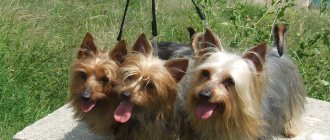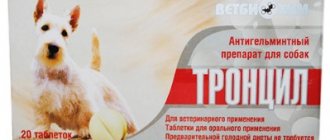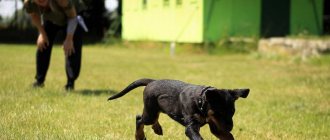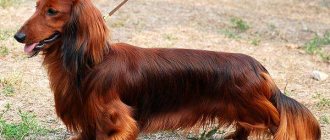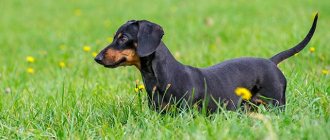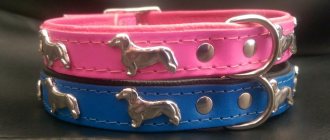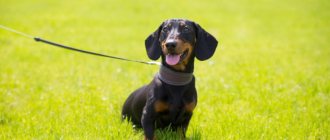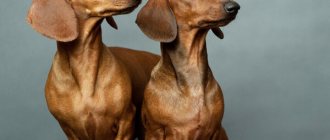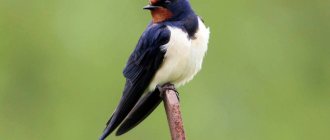The dachshund is probably the most famous dog in the world. Despite the fact that the breed was bred for badger hunting, it is warm-hearted and sociable, but it has become an excellent companion and an undoubted favorite of children. Everyone knows what a dachshund looks like: it is a small dog, with an elongated body on short legs and floppy ears. Funny, lively and playful. But it is precisely this body structure that has become the cause of some diseases that are inherent in this particular breed. What are the most common dachshund diseases, and how to identify and prevent them, our article will help you figure it out.
Dachshund diseases and their identification
In most cases, the Dachshund is in good health, has an active temperament and does not cause health problems or difficulties in caring for. The average lifespan of the breed is 12-14 years. The main ailments to which the breed is susceptible are the following:
- discopathy;
- osteoporosis (swimmer's syndrome);
- obesity;
- problems with the heart, kidneys, pancreas;
- epilepsy;
- acanthosis nigricans;
- ear infections;
- retinal atrophy;
- cataract;
- viral infections (leptospirosis, enteritis, adenovirosis).
You should be attentive to the health of your pet, and if there is the slightest change in behavior or well-being, consult a veterinarian. If your animal has the following symptoms, this is a reason to consult a doctor:
- decreased activity, anxiety;
- loss of appetite, weight loss, vomiting, diarrhea;
- increased body temperature (above 38.5 degrees) or decreased (below 37.5 degrees);
- pallor, cyanosis or bleeding of mucous membranes;
- bad breath;
- baldness;
- pressing the hind limbs towards the stomach in a lying position;
- bending of the back from pain, loss of coordination of movements.
Chapter Caring for an Elderly Dog
- Changes in character and behavior
- Dachshund's old age period
- Feeding an old dog
- Should you euthanize an old dog or not?
- Diseases of older dogs
- General recommendations (homeopathy)
- Death of a dog
So, your pet must leave you - this is inevitable. Some people get a young dog ahead of time - this softens the bitterness of parting. But an old dog is not always happy about the arrival of a puppy. A puppy with his boundless energy, disrespect for the old dog’s property, his place, his toy, his dinner, and his appropriation of the owner’s attention will cause irritation and jealousy in your old friend. If you didn't adopt a partner for your dog when it was still young, you shouldn't do it when it feels weak and aging.
Older dogs behave more sedately, with dignity, become conservative in their habits, and therefore have difficulty withstanding a change of environment. They can become disobedient, irritable and grumpy. The character deteriorates especially in dogs suffering from serious illnesses and experiencing constant pain due to this. Some dogs become fearful and unsure of their abilities. Others bully young dogs and try to maintain leadership.
Dogs become more intrusive, jealous, touchy towards their owner, and may withdraw into themselves and avoid communication. Spending most of the day half asleep, at night the “old men” wander around the apartment - suffering from insomnia.
Dogs have a hard time withstanding emotional and physical stress, and stress is simply destructive for them.
Old age brings diseases: rheumatism, arthritis, toothache, liver disease, bladder disease, etc. You cannot treat old age, but you can help an old dog live out its last years happily. It all starts with taking care of your pet's health throughout its life. This care includes regular veterinary examinations, deworming, dental and ear care, regular exercise, and an appropriate diet.
Old dogs have reduced motor activity and an increased tendency to obesity. This makes it clear how important it is to feed your dog properly.
Don't let her get fat, although this can be very difficult to do. For older dogs, low-calorie food with low protein, carbohydrates and high fiber, vitamins, and vegetable oils is recommended.
Many older dogs are very bothered by severe toothache. The dog resists and trembles when we want to examine its teeth, and then rubs its muzzle with its paws. This means she is feeling a lot of pain. Diseased teeth need to be removed on time. She will become sociable and cheerful again.
Dogs often suffer from ear pain. It is more difficult to deal with than toothache. There is only one way - from puppyhood, keep your ears clean and in good condition. Preventive cleanings once a week for the rest of your dog's life will relieve your dog of pain in old age.
An old dog can become deaf and blind. This will force you to treat her even more tenderly than before - there is no other way out.
Sometimes older dogs suffer from urinary incontinence. It is impossible to treat this vice; all that remains is not to scold your old friend, but to cover the bedding with a layer of old newspapers at night.
Wool also “gets old.” It acquires an unpleasant odor, thins out, and the skin becomes oily. Wiping the fur with a sponge soaked in a solution of vodka and 9 percent vinegar (1:1) will help. This simple procedure will eliminate the odor.
It is necessary to protect the old dog from rain and cold. On inclement days, it is better to take the dog for a walk in a warm blanket.
Particular attention should be paid to the dog’s place in the apartment. It should be as far as possible from drafts and be soft and comfortable.
An old dog becomes very slow and does everything after much thought. Don't rush her or stress her out. Be careful when you have to go up or down stairs - over the years, stairs become a serious obstacle for a dog. Don't yank it, old dogs feel unhappy when they are spoken to loudly, harshly or forced to rush. You need to be careful and patient.
Dachshunds live longer than 12 years, but signs of aging appear in them after 8 years, during this period less dynamic behavior, joint pain, dulling of the coat with the appearance of white hairs, and decreased appetite are observed. It is still too early to talk about old age, but you need to take some steps to change your diet to reduce the problems associated with age.
A light regimen is introduced when the dog shows signs of being overweight. In adult individuals, on the contrary, it is necessary to maintain sufficient energy value of the diet and improve the quality of the components used to compensate for some of the difficulties that may arise during the assimilation of food. Contrary to popular belief, the amount of protein in older dogs' diets should be reduced. But proteins allow the dog to maintain muscle and protect itself from infection. Since aging dogs are less successful at digesting protein from food than younger dogs, the quality of protein needs to be improved.
To slow the gradual decline in kidney function, reducing dietary phosphorus intake is effective.
The old dog is slow to move, sleeps a lot and plays little. She no longer pleases with enthusiasm and energy, she becomes slow and weak. An older dog seeks a warm, comfortable place and may sleep all day. The dog's coat changes. Usually it turns gray, becomes thin and brittle. The elderly dog is in no hurry to respond to the owner’s call and is capricious.
Dogs age faster than we would like, and it always happens unexpectedly. For each animal, old age occurs at different times and depends on the size of the dog, breed, and state of health. Small dogs usually live longer. Many dachshunds live up to 20 years, and become old only at the age of 10–12 years, while large dogs become old at 6–8 years. For orientation: dogs weighing up to 10 kg live 15 years or more, medium-weight dogs - 11-14 years, and heavyweight dogs - 8-10 years.
How should an owner react to an aging dog? The first thing you need to do is become especially attentive as your pet and friend enters middle age. (For a dachshund, this is 10 years.) What does this mean? Sometimes it is easy to make the mistake of overlooking a serious illness and mistaking a dog's decreased activity as a sign of old age. Symptoms of the disease include weight loss, loss of appetite, increased thirst, frequent urination, difficulty breathing, exhaustion, vomiting, bad breath or gum disease.
In short, you should be wary of any changes in the behavior of an elderly dog - reluctance to go for a walk, involuntary urination, lethargy. These are signs that your pet is unhealthy.
Dog lovers have accumulated a wealth of experience in caring for older dogs, let’s summarize this experience.
Take your dog to the vet 2 times a year. Blood and urine tests done on a healthy dog will allow you to find out the norm, which will be needed for comparison when it gets sick. It is necessary to introduce the rule of regular examinations of the dog by a veterinarian. He must listen to her heart, lungs, examine her teeth, eyes, ears and lymph nodes.
There is an opinion that old dogs do not need to be vaccinated. This opinion is extremely dangerous. As pets age, they become more susceptible to disease and need the protection that vaccines provide to your friend's weakened immune system.
Under no circumstances should you postpone a visit to the veterinarian if you notice a deterioration in your pet’s health. Do not wait for the situation to worsen when the disease leads to irreversible processes.
Your dog's teeth need to be cleaned regularly, on their own, using a special toothpaste for pets. By the way, dogs like the taste of the paste, so they quickly get used to this procedure. (About 85% of all older dogs suffer from dental and gum disease.)
Brush your dog regularly. Older dogs need more frequent bathing and shampoo.
While brushing, be sure to feel your dog to check for swelling. Examine the skin and fur, ears and eyes. The mucous membranes of the eyes should be pink (as well as healthy ones).
About sterilization and castration. These operations can prevent tumors of the mammary glands and prostate, but it is best to perform them on a young dog. In old age they are also not contraindicated and can be effective.
Do not change your routine so as not to stress your old dog. She should live in a familiar family environment and eat regular food. When you get a new pet, be sure to pay more attention to your old friend.
About physical activity. They should be moderate - several short walks a day. If your dog is tired and breathing heavily, you should consult your veterinarian.
The main attention should be paid to the quality of the feed. In this case, it is better to stick to the usual set of foods, because a sudden change in diet ends in digestive upset. Dogs with chronic diseases can be switched to dietary nutrition as prescribed by a doctor. Following a diet in this case is one of the important conditions for the well-being of an elderly dog.
Older dogs become very picky eaters, and some are always hungry. Bulimia (satiation disorder) is dangerous not only due to overeating, but also because by eating everything, the dog runs the risk of poisoning. Poor appetite and gluttony are a serious reason to visit a doctor.
It is advisable to use complexes developed specifically for older dogs - “Dekamevit” or veterinary drugs. When choosing vitamins, you should consult your doctor. Some drugs contain eleutherococcus and similar substances that increase the dog’s vitality, but are contraindicated for liver diseases. “Vitapet” has proven itself to be excellent. It improves well-being, increases activity, and has a beneficial effect on the condition of joints.
Feed your older dog high-quality food that is balanced in vitamins and minerals. Dogs often become overweight as they age, and obesity in turn leads to other health problems, so it is important to follow special diets.
If an old dog's life is becoming a torment for him, you must relieve him of it. It’s hard to decide on this, but your last duty is to do this for her.
Take your old friend to the vet yourself. If you can't bear it, ask someone your dog loves and trusts to help you. Don't let your dog die feeling useless in the arms of a stranger.
In older dogs, it is not easy to draw the line between age-related changes and diseases. Symptoms of diseases are weak and owners do not always pay attention to them in a timely manner. Some dogs become dependent on the weather, which can be misleading for owners to blame their illness on the weather. By old age, animals usually acquire a bunch of diseases. This must be taken into account when prescribing drug therapy, so as not to upset the delicate balance in the aging body. Sensitivity to drugs also changes. The dosage of even the most harmless drug should be selected taking into account age, since intoxication may occur due to decreased liver and kidney function.
An old dog needs exercise to maintain muscle tone and joint flexibility, but the dosage of exposure to air should be reasonable. In good weather you can linger outside for a while. You should not follow the lead of dogs that have retained their temperament and playfulness into old age.
In old dogs, even minor injuries heal very poorly, so you need to watch your dog closely when walking. After playing or fighting with other dogs, an older dog may experience pain in the legs or spine. Overexertion while walking is fraught with weakness, attacks of cardiac arrhythmia and shortness of breath.
Old dogs are most susceptible to diseases such as cancer, kidney, liver and heart diseases. If the diagnosis is made at an early stage of the disease, you can extend the dog's life by several years.
Let's look at the most common diseases of older dogs.
KIDNEY DISEASES. In dogs, the kidneys “age” the fastest. Experts believe that every dog over 8 years of age suffers from kidney failure. However, diseased kidneys still serve the dog, which, unfortunately, often leads to the fact that kidney failure is not diagnosed in a timely manner. Serious symptoms may not appear until 60–75% of kidney function is lost. The disease progresses slowly. The first sign is that the dog drinks more and asks to go outside more often. Later, appetite disappears, weight decreases, vomiting, diarrhea or constipation, and lethargy are possible. Uncleanliness in the home can also be a symptom of kidney failure, although some spayed female dogs become incontinent in old age, even when healthy.
If one or both kidneys are diseased, toxic substances accumulate in the body. Diagnosis can be made by blood and urine tests.
Treatment of renal failure. The dog is prescribed phosphorus and salt, as well as antibiotics and steroids. Kidney transplantation is possible, but rarely done.
LIVER DISEASES. The liver eliminates toxins from the dog’s body, controls blood composition, and helps absorb proteins and glucose. Impairment of this organ in older dogs can occur due to inflammation, infection, injury, or long-term use of medications that support liver metabolism. Symptoms of the disease - lethargy, loss of appetite and weight - are often mistaken by owners for age-related changes.
In more serious cases, high fever, vomiting, jaundice, increased thirst, depression appear, and upon palpation there is a noticeable enlargement of the liver. Diagnosis is made based on blood and urine tests or liver biopsy. Your dog needs a low sodium diet.
HEART FAILURE. The disease occurs in dogs over 5 years of age and can be caused by wear and tear of the heart valves and muscles, age, or infections. Symptoms: difficulty breathing, cough, weakness, swelling of the legs or abdomen, bluish tongue or gums. Diagnosis includes a chest x-ray, electrocardiogram, blood pressure measurement and ultrasound.
A sick dog is recommended low-salt food, potassium, and vitamin supplements. The dog is limited in physical activity. It is necessary to strictly monitor your weight as obesity can lead to heart disease.
CANCER. The most common form of cancer found in dogs is lymphoma. It begins in the lymph nodes, but can spread to any organ.
How to detect the disease? Often, older dogs develop tumors and Pomors. It is important to take your dog to a veterinarian to determine whether these skin growths could be malignant.
Treatment. Chemotherapy is a standard treatment that puts some cancers into remission.
VISION. After eight years, the dog's visual acuity decreases. This is due to various diseases: glaucoma, atrophy of the retina and optic nerve, age-related changes in the lens. The beginning of a cataract is indicated by a barely noticeable bluish “haze” in the dog’s eyes. To stop the process, eye drops are used: Katahrom - Oftan, Taufon, 1-2 drops 2-3 times a day in long courses. If cataracts have developed, surgery is indicated. If this is not possible, then the blind dog should only be walked on a leash along a familiar route. At home, to prevent the dog from being injured, do not leave dangerous objects in its path.
Deterioration of vision is indicated by such signs as the dog’s reluctance to walk in the dark, caution, and overcoming minor obstacles with difficulty or with “reserve.”
Blindness of even one eye can lead to unexpected reactions - fear or aggression towards familiar dogs that happen to be on the side of the affected eye.
Signs of vision loss are a cautious gait, sniffing the road. The dog tries it on before each step, bumps into objects, and behaves insecurely.
For dogs, vision loss is not a tragedy. They begin to navigate using other senses, primarily smell and hearing. The owner’s task is to reduce the risk of injury if possible, teach the dog basic commands (for example, “stand”, “quiet”, “forward”) so that the dog feels more confident and relies not only on itself, but also on the owner.
HEARING. Hearing loss is another natural change in the aging body. More often, dogs with chronic otitis media lose their hearing. Hearing loss is not as obvious as vision loss. Having lived a long life with a person, the dog is guided not only by the voice, but also by changes in facial expressions, gestures, it understands familiar commands and words from the lips. Suspicions arise when a dog does not pay attention to commands, gets lost during walks, despite the owner’s calls, and runs in the other direction.
A dog with hearing loss must be walked on a leash. It is, of course, impossible to restore hearing, but timely treatment of otitis media and proper ear care reduce the likelihood of deafness in old age.
LEATHER. With age, the skin loses its elasticity, the sebaceous glands produce less secretion, and dandruff appears. The coat becomes dull and seems unkempt. Regular brushing will rid the skin of lost hair, dandruff, and improve blood circulation. The brush should be soft so as not to scratch the skin, because scratches in older dogs can easily become infected.
An old dog's claws hardly wear down, making it difficult to walk and causing lameness. They should be periodically inspected and trimmed if necessary. Old dogs get cold easily, so they are rarely washed; it is better to clean them with a special shampoo.
ABOUT CLEANNESS. An old dog may lose control of its natural needs and begins to recover in the apartment. In old animals, many conditioned reflex connections fade; they “forget” that they need to ask for a walk. There is no point in scolding and punishing an old dog for “doing things” in the apartment; it is better to increase the number of walks.
Some older dogs drink a lot of fluids, which can cause enuresis. Thirst is often associated with impaired renal function. It is very difficult to cope with the disease, but you cannot limit your dog’s access to water. It’s better to take her out more often so she doesn’t have to endure it for long. Increased thirst can be a symptom of other diseases: pyometra, diabetes, etc. To clarify the diagnosis, you need to show the dog to a doctor.
How can we help our pet, who has aged, but has not become less dear to us and continues to remain a member of the family?
Most older dogs suffer from osteoarthritis, which typically results in joint stiffness. Worsening occurs from cold and dampness. In this case, you can use the drug Cel. It must be used for a long time - at least 1.5-2 months, usually 2-3 injections per week.
Sometimes in old age a dog becomes nervous, irritable, and fearful. Improvements can be expected from the use of Berberis-Homaccord and Nux vomica-Homaccord and Phosphorus-Homaccord. The latter drug is indicated for animals that are afraid of thunderstorms, gunshots, and sharp sounds. The duration of treatment is from 2 to 6 months with injections 1–2 times a week.
Diseases of the gums and teeth prevent the dog from eating and serve as a source of infection. Therefore, monitor the condition of your pet’s oral cavity and remove tartar regularly. If your dog already has periodontal disease, you can use Traumeel by injection or orally, and treat the teeth and gums with tea tree oil. Treatments must be carried out daily for at least 2 weeks.
Constipation often occurs in older animals. As a rule, they are caused by improper feeding, weakness of the abdominal muscles and intestinal atony. Do not give your dog bones: their sharp edges can injure the mucous membrane of the stomach and intestines and lead to very serious consequences. If your dog has chronic constipation, feed him easy-to-digest foods in small portions. Milk, rolled oats, liver, and bran have a laxative effect on some animals. In mild cases, laxatives are given orally - Vaseline or vegetable oil 3-4 teaspoons per day, depending on the size of the animal. Do not give laxatives regularly as your pet will become addicted. Antihomotoxic drugs that can be recommended are Mucosa-Composium and Nux vomica Homaccord. They can be used for a long time.
A few words about such a drug as Coenzyme compositum. It is the main “senile” remedy. Its homeopathic components, trace elements, enzymes and vitamins in homeopathic doses have a broad, but not overly strong effect on most systems. This drug is indicated for all aging animals, and also, along with Traumelen, for various malignant tumors to improve general well-being.
This misfortune falls not only on you, but on everyone in the house - children, adults and animals who lived together.
The death of an animal is a tragedy in the family. The child must feel this tragedy fully if the dog’s life ended suddenly: it fell under the wheels of a car, or died from an infectious disease. If an old, decrepit dog had to be euthanized, if the dog has an incurable disease and is suffering, then it is better to tell the baby that the dog was taken to the clinic, where it underwent surgery, and then it was transported to a sanatorium for further treatment. Otherwise, you can cause severe mental trauma to the child.
If a dog dies at home in front of your child, don't talk about getting a new one to replace the old one. A new dog will never replace an old one for a child. This will turn your child into an indifferent person. Wait, maybe the child himself will say that he wants a new dog.
When a beloved dog dies, a painful devastation reigns in the soul for a long time. There are still regrets that a lot of things should have been done differently, giving the dog more love and attention. It happens that people, having lost a dog, remain faithful to the memory of it and decide that another will never enter their home again. It's hard to choose between wanting to love a face, a tail and four legs and being loyal to your first friend. There will be separation and pain again - after all, people live longer than dogs, but imagine how much happiness awaits you if you again give your heart to a weak and cute puppy.
Konrad Lorenz in his book “A Man Finds a Friend” wrote: “In human life, every joy is paid for with sadness, and I consider a corpse to be the one who refuses the few harmless and ethically impeccable pleasures available to man, only out of fear that sooner or late fate will present him with an account for them...” If, having lost a dog, you take a puppy of the same breed, then in the normal course of events you will soon be convinced that he will fill the void in your heart and life that arose after the loss of your old four-legged friend.
When we lose a dog, we lose our future together. Never again will she come running to wake you up in the morning, poking you with her wet nose and delicately licking your face. After the death of a friend, a person feels lost and, in order to get out of this state and return to normal life, psychologists advise: do not restrain your feelings in the presence of people close to you.
When there are several dogs or other animals in a family, and especially if they are friends with each other, then another problem arises: often the remaining animal is very bored when suddenly, unexpectedly, its partner disappears. During a walk, a dog may break off its leash after similar dogs flashing in the distance.
And in this case, the proven method usually helps best - get a puppy of the same breed. If your dog is used to living with another dog, and together they formed a small pack of dogs, then when left alone, it suffers greatly. Most likely, she will take every possible care of the new baby and raise him according to her own rules.
Table of contents
Spinal problems in dachshunds
Problems with the spine of the dachshund are caused by the structure of its body - most often it affects small breeds with a long body and short legs. The reason for this is the excessively large loads on the spine due to the disproportionate structure of the body. This is fraught with a decrease in motor activity for pets and can even lead to paralysis.
Intervertebral hernia in a dachshund
A herniated disc is characterized by displacement of the nucleus pulposus of the intervertebral disc, which leads to bulging or rupture of the annulus fibrosus. In this case, compression of the spinal cord occurs, which causes the development of neurological disorders.
Symptoms:
- decreased overall activity;
- painful sensations when pressing on the back;
- muscle spasms of the back and neck;
- not very confident movement;
- dragging of paws;
- frequent arching of the back;
- hind limb failure;
- involuntary urination and defecation.
To draw up a clinical picture, a veterinarian conducts an examination, prescribes tests and x-rays. At the initial stage, medication and physiotherapeutic procedures may be sufficient. In severe cases, surgery may be necessary.
Drug treatment
At the initial stage of the disease, drug treatment is allowed, which helps relieve symptoms, but does not cure the disease.
For conservative treatment of discoptia, the veterinarian prescribes:
- Corticosteroid hormones.
- Vitamin "B" injections.
- Non-steroidal anti-inflammatory drugs such as Rimadyl, Previcox, Ketofen.
- Painkillers.
- Chondroprotectors to maintain cartilage structure, such as Flexan. Such substances contain bioactive collagen molecules, which slow down degenerative processes in the spine.
- Drugs that relieve inflammation, for example, Canina Petvital Frnhro tabletttn. Such drugs help to establish balance in the inert tissue and increase the elasticity of the ligaments, which bear additional stress due to the loss of functionality of the spinal disc.
Paw diseases: osteoporosis
Osteoporosis (swimmer's syndrome) often affects puppies and appears in the first month of life, or older dogs. The disease is characterized by rarefaction of bone tissue, when resorption processes occur more often than its formation. It can be caused by a lack of vitamins and microelements, in particular calcium and phosphorus.
Symptoms:
- limbs move apart when trying to stand on their feet;
- the dog tries to move on its stomach;
- It is difficult for the puppy to roll over.
From an early age, the puppy should be closely monitored and examined by a veterinarian. Therapy is aimed at drug treatment, nutritional correction, and additional vitamin intake. Diagnosing the problem at an early stage in a puppy will allow for proper treatment, and then there is a chance for recovery.
Dachshund skin diseases: acanthosis nigricans
This is another common disease among dachshunds, which is also called skin dystrophy. The reasons can be very different - genetic predisposition, the consequences of hormonal imbalances, diabetes or hypothyroidism, as well as stress or obesity. Affects the skin under the arms, abdomen, chest, thighs.
Symptoms:
- skin pigmentation;
- hair loss;
- thickening of the skin and the formation of a large number of folds;
- unpleasant smell.
Upon examination, a veterinarian can diagnose the presence of the disease. For treatment, corticosteroid drugs and ointments containing sulfur and vitamin A are prescribed. In addition, it is important to provide the pet with a diet and special care.
Diagnostics
If a dachshund drags its hind legs because they have failed, you need to find out the reason by making an accurate diagnosis. The veterinarian conducts an examination, finds out how much sensitivity has been lost and prescribes tests and research:
- blood and urine tests;
- Ultrasound of internal organs;
- computed tomography;
- X-ray examination with contrast.
Kidney diseases
Diseases of the kidneys and genitourinary system in the breed may not be observed very often, however, the following are sometimes diagnosed:
- nephritis;
- pyelonephritis;
- glomerulonephritis;
- polycystic disease;
- nephrosis;
- nephrosclerosis.
Symptoms:
- loss of appetite;
- extreme thirst and increased drinking;
- disruption of the gastrointestinal tract;
- bad breath;
- swelling of the limbs;
- apathy and lethargy.
If you notice the first signs of kidney problems or problems with urination, you should immediately consult a doctor. At the clinic, your pet will undergo diagnostics, tests, ultrasound, and will also be prescribed the necessary treatment. Therapy includes medications that must be prescribed by a veterinarian. The dog’s diet is also regulated and proper care is provided.
Oncology
The most common disease diagnosed in older dogs is cancer. The body's defenses are not able to promptly destroy cancer cells that form in the animal's body, so the older the dog, the higher the risk of developing a malignant tumor.
The danger of the disease is that it does not manifest itself for a long time and is difficult to diagnose. Clinical signs directly depend on the location of the tumor.
Types of oncology in dogs:
- Uterine cancer. Occurs as a result of uncontrolled use of hormonal drugs that delay and prevent estrus. The main symptom is constant spotting and spotting.
- Stomach cancer. Signs: weakness, anemia, unstable functioning of the digestive tract, vomiting, constipation, diarrhea, unpleasant odor from the dog’s mouth. But these signs are also the cause of the disease - cholecystitis in a dog: symptoms and treatment here.
- Lung cancer can be identified by a dry cough, which in later stages turns into a cough with pus and blood.
- Breast cancer. Main symptoms: hard nodules, lumps on the glands. Over time, tumors increase in size and change color.
- Kidney cancer is determined by the presence of blood in the urine, the dog’s poor health, lack of appetite, and painful sensations.
The prognosis depends on many factors: age, type of oncology, state of health of the animal. It is almost impossible to cure cancer in an elderly dog, since the disease progresses quickly, and surgery is not always possible.
In such cases, the veterinarian controls the pain to alleviate the pet's suffering. If surgical intervention is impossible for medical reasons, the question of euthanasia arises.
Heart diseases
Diseases of the cardiovascular system in dachshunds can be either congenital or acquired. Congenital are associated with the heart valves and blood vessels, and appear at an early age. Acquired heart disease is a consequence of previous infectious diseases or age-related changes in the body. These include:
- anemia;
- myocarditis;
- endocarditis;
- atherosclerosis;
- acute or chronic heart failure.
Symptoms:
- apathy and immobility;
- fast fatiguability;
- dyspnea;
- swelling;
- pallor or cyanosis of mucous membranes;
- cold extremities and ears;
- temperature increase;
- irregular heartbeat;
- fainting.
To diagnose the disease, the doctor may prescribe echocardiography and electrocardiogram. Depending on the type of illness, the pet may be prescribed heart medications, as well as in some cases (for example, with endocarditis) antibacterial, anti-inflammatory and antipyretic drugs.
Epilepsy
Idiopathic epilepsy is relatively often observed in long-haired dachshunds, as a consequence of a congenital anomaly of the nervous system.
Before attacks, the dog becomes very anxious, does not respond to external stimuli, the head muscles twitch, and the gait becomes unsteady. Immediately after this, the animal loses consciousness, convulsions appear, and breathing is hoarse. The duration of the attack is from several seconds to an hour. After an attack, the dachshund is disoriented, does not recognize its owners and is in prostration.
Epilepsy is treated with sedatives, most often phenobarbital.
Please do not despair if you have been diagnosed with this! With high-quality therapy, the pet is guaranteed a long and high-quality life.
Eye problems in dachshunds
There are several eye diseases in dachshunds, such as retinal atrophy and cataracts. But the most common is glaucoma, which is characterized by increased pressure, which leads to destruction of the retina and optic nerve. There are primary and secondary.
Symptoms:
- frequent blinking;
- pain in the eyes;
- changes in the position of the lens;
- tearfulness;
- enlargement of the eyeball;
- apathy and lethargy.
At the clinic, the pet will undergo a medical history, external ophthalmological examination, tonometry, biomicroscopy and other necessary studies depending on the severity of the condition. If glaucoma is secondary, medications are prescribed to treat the underlying disease. In addition, medications to lower IOP and neuroprotectors are required. In difficult cases, laser treatment is prescribed.
Obesity dachshund
The dachshund is a hunting breed of dog with a desire for activity, an active lifestyle and certain physical activities in its blood. There are often cases when owners, for various reasons, do not pay due attention to the physical education of their pet. In addition, breeders pamper their pets by feeding them between meals or treating them to treats.
Elementary non-compliance with the feeding schedule and a sedentary lifestyle lead to obesity. This not only causes discomfort to the dog, but also causes the development of dangerous diseases: diabetes, problems with the cardiovascular system, discopathy. You can prevent the development of diseases by following simple rules:
- The animal must be fed strictly according to a schedule, no more than 2-3 times a day for an adult;
- the diet must be complete and balanced, containing all the necessary vitamins and microelements;
- Walking the dog should be frequent, with moderate physical activity recommended for this breed.
Preventive measures
To ensure that the dog’s hind legs are healthy and do not fail unexpectedly for the owner, preventive measures are carried out:
- Maintain a balanced diet.
- Maintains the pet's normal weight.
- A puppy is fed milk, an adult dachshund is given fermented milk products.
- They walk him on a leash and do not allow him to jump from great heights.
- Protect from stress.
- Avoid meeting other people's dogs.
- Eliminate the possibility of contracting dangerous infections.
- The dachshund gets x-rayed regularly.
- Give your pet chondroprotectors.
Vaccinations for dachshunds: when and which ones to give?
Like any other breed, the dachshund is susceptible to various viral infections. Among the most common are leptospirosis, enteritis, adenovirosis, as well as hepatitis, rabies and plague. Therefore, it is necessary to vaccinate the animal in a timely manner. The vaccination schedule for puppies is as follows:
- At two months, the puppy is vaccinated against plague, hepatitis, adenovirus and enteritis.
- After two weeks, vaccinations are repeated.
- At seven months, they are re-vaccinated against plague, hepatitis, adenovirus and enteritis, and also add a vaccination against leptospirosis.
- Rabies vaccination is added every year.
From the first year of life until the last days, a set of vaccinations is carried out annually. Before vaccination, your pet needs to be prevented from helminthic infestation.
Factors influencing life expectancy
Life expectancy is greatly influenced by two objective circumstances - breed and genetics. As you know, small dogs often become long-lived; heredity depends on the puppy’s parents. In addition to these factors, there are others that should be taken into account in order to see your pet alive and healthy for as long as possible. Among them:
- Physical development - the more time you spend with your dog in the fresh air, providing it with training and feasible exercise, the better its physical shape.
- Maintenance – living at home, warm and without drafts, protects the pet from diseases.
- Childbirth - uncontrolled and repeated negatively affects the body of bitches.
- Nervous system – stressful situations significantly shorten the life of dogs.
- Sterilization - according to scientists, reduces the risk of cancer of the genital organs and inflammation of the uterus.

